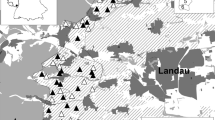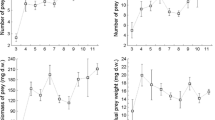Abstract
We compared habitat use and diets of young Capercaillie and Black Grouse broods in a boreal forest in southeast Norway. We used pointing dogs to search for broods (N = 83) in mature “natural” forest types and examined the crop content of 66 chicks 1–9 weeks old. We also measured the abundance of insects in the habitats where broods were found. Although overlapping substantially in both habitat and diets, there were notable differences: Capercaillie broods were more frequently recorded in bilberry-dominated forest types, whereas Black Grouse preferentially used pine bog forest, a more open habitat with little bilberry. Capercaillie chicks ate proportionally more insects, particularly lepidopteran larvae, and insects dominated their diet for a longer period of time (until age 28–29 days) than in Black Grouse (14–15 days). After reaching their peaks, the quantity of insects in the crops declined rapidly especially in Capercaillie, and in one of 2 years this occurred at a time when insects, including larvae, were still abundant in the habitats. Among plant foods, both species ate large amounts of Bilberry (Vaccinium myrtillus) and Bog Whortleberry (V. uliginosum). The main difference between species was a large proportion of both over-wintered and new, not yet ripe, berries of Cranberry (Oxycoccus quadripetalus) in Black Grouse, and a higher proportion of the forb Melampyrum sylvaticum in Capercaillie. The difference in diets reflected their differential use of habitats; the Vaccinium-preferred habitats of Capercaillie were richer in insects, particularly larvae, than the pine bog habitat preferred by Black Grouse. Because insects, especially larvae, comprised a larger proportion of the diet of Capercaillie chicks and chicks of this species need more food to sustain their rapid growth, Capercaillie is likely to be more sensitive to variation in insect food than Black Grouse. Also, by reducing the abundance of bilberry, the main host plant of larvae chick food, clearcutting forestry has negative effects on the brood habitat quality of both species.





Similar content being viewed by others
References
Atlegrim O (1991) Interactions between the bilberry (Vaccinium myrtillus) and a guild of insect larvae in a boreal coniferous forest. PhD dissertation, Swedish University of Agricultural Sciences, Umeå
Atlegrim O, Sjöberg K (1995) Lepidoptera larvae as food for capercaillie chicks (Tetrao urogallus). Scand J For Res 10:278–283
Baines D, Wilson IA, Beeley G (1996) Timing of breeding in black grouse Tetrao tetrix and capercaillie Tetrao urogallus and distribution of insect food for the chicks. Ibis 138:181–187
Børset E, Krafft A (1973) Black grouse and capercaillie brood habitats in a Norwegian spruce forest. Oikos 24:1–17
Kaasa J (1959) En undersøkelse over næringen hos orrfuglen (Lyrurus tetrix (L.) i Norge. Summary: On the knowledge of the food of the black grouse (Lyrurus tetrix (L.)) in Norway. Papers of the Norwegian State Game Research 2:112 pp
Kardell L (1980) Occurrence and production of bilberry, lingonberry and raspberry in Swedish forests. Forest Ecol Manage 2:285–298
Kastdalen L (1986) Food selection in capercaillie and black grouse chicks in south-east Norway. MSc Thesis, University of Oslo, Norway
Kastdalen L, Wegge P (1985) Animal food in capercaillie and black grouse chicks in southeast Norway—a preliminary report. Int Grouse Symp 3:499–513
Kielland-Lund J (1981) Die Waldgesellschaften S–O Norwegens. Phytocoenologia 9:53–250
Kolstad M, Bø T, Wegge P (1985) Orrfuglens (Tetrao tetrix L.) habitatøkologi om våren og sommeren i Øst-Norge. Summary: the habitat ecology of black grouse (Tetrao tetrix L.) during spring and summer in East Norway. Norwegian Wildlife Research 13:46 pp
Manly BFJ, McDonald LL, Thomas DL, McDonald TL, Erickson WP (2002) Resource selection by animals. Statistical design and analysis for field studies. Kluwer, The Netherlands, 211 pp
Moss R, Hanssen I (1980) Grouse nutrition. Nutr Abstr Rev Ser B 50:555–567
Moss R, Oswald J (1985) Population dynamics of capercaillie in a north-east Scottish glen. Ornis Scand 16:229–238
Moss R, Watson A (2001) Population cycles in birds of the grouse family (Tetraonidae). Adv Ecol Res 32:53–111
Picozzi N, Moss R, Kortland K (1999) Diet and survival of capercaillie (Tetrao urogallus) chicks in Scotland. Wildl Biol 5:11–23
Rajala P (1959) Metsonpoikasten ravinnosta. (On the food habits of capercaillie juveniles). Suomen Riista 13:143–155
Rolstad J, Wegge P (1988) Capercaillie habitat: a critical assessment of the role of old forest. Int Grouse Symp 4:238–253
Savory CJ (1989) Th importance of invertebrate foods to chicks of gallinaceous species. Proc Nutr Soc 48:113–133
Semenov-Tjan-Sanskij OJ (1960) Die Økologie der Birkhuhnvøgel (Tetraoniden). Translation No. 106 by the Swedish Research Council, 306 pp
Southwood TRE (1980) Ecological methods: with particular reference to the study of insect populations. Chapman and Hall, London, 524 pp
Spidsø TK (1980) Food selection by willow grouse Lagopus lagopus chicks in northern Norway. Ornis Scand 11:99–105
Spidsø TK, Stuen OH (1988) Food selection by capercaillie chicks in southern Norway. Can J Zool 66:279–283
Storch I (1994) Habitat and survival of capercaillie nests and broods in the Bavarian Alps. Biol Cons 70:237–243
Storch I (2000) Grouse status survey and conservation action plan 2000–2004. World Pheasant Association, Reading, UK, and Birdlife International, Cambridge
Stuen OH, Spidsø TK (1988) Invertebrate abundance in different forest habitats as animal food available to capercaillie (Tetrao urogallus) chicks. Scand J For Res 3:527–532
Summers RW, Proctor R, Thornton M, Avay G (2004) Habitat selection and diet of the Capercaillie Tetrao urogallus in Abernathy Forest, Strathspey, Scotland. Bird Study 51:58–68
Wegge P, Rolstad J (1986) Size and spacing of capercaillie leks in relation to social behavior and habitat. Behav Ecol Sociobiol 19:401–408
Wegge P, Finne M H, Rolstad J (2007) GPS satellite telemetry provides new insight into capercaillie brood movements. Wildl Biol 13(suppl 1):87–94
Wegge P, Storaas T, Larsen BB, Bø T, Kolstad M (1982) Woodland grouse and modern forestry in Norway. A short presentation of a new telemetry project and some preliminary results on brood movements and habitat preferences of capercaillie and black grouse. Int Grouse Symp 2:117–123
Wegge P, Olstad T, Gregersen H, Hjeljord O, Sivkov AV (2005) Capercaillie broods in pristine boreal forests in northwestern Russia: the importance of insects and cover in habitat selection. Can J Zool 83:1547–1555
Wegge P, Kastdalen L (2007) Pattern and causes of natural mortality of capercaillie, Tetrao urogallus, chicks in a fragmented boreal forest. Ann Zool Fenn 44:141–151
Acknowledgments
T. Storaas, B. B. Larsen, J. Halvorsrud, P. Aas and T. Øfstaas assisted during fieldwork, and J. Rolstad and an anonymous referee provided constructive input to the manuscript. The Norwegian Directorate of Nature Management funded the study.
Author information
Authors and Affiliations
Corresponding author
Additional information
Communicated by F. Bairlein.
Rights and permissions
About this article
Cite this article
Wegge, P., Kastdalen, L. Habitat and diet of young grouse broods: resource partitioning between Capercaillie (Tetrao urogallus) and Black Grouse (Tetrao tetrix) in boreal forests. J Ornithol 149, 237–244 (2008). https://doi.org/10.1007/s10336-007-0265-7
Received:
Revised:
Accepted:
Published:
Issue Date:
DOI: https://doi.org/10.1007/s10336-007-0265-7




